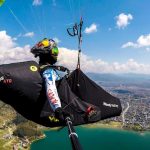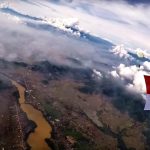Download links
How to install Soaring to New Heights: The Thrill of Wingsuit Flying APK?
1. Tap the downloaded Soaring to New Heights: The Thrill of Wingsuit Flying APK file.
2. Touch install.
3. Follow the steps on the screen.
Description
Wingsuit flying, a breathtaking blend of human ingenuity and the primal desire for flight, has a rich history that dates back to the early 20th century. The concept of gliding through the air with a suit designed to enhance lift and control can be traced back to the pioneering work of early aviators and inventors. One of the first recorded instances of a wingsuit-like apparatus was in 1912 when French inventor Franz Reichelt attempted to fly from the Eiffel Tower using a parachute suit he designed.
The modern era of wingsuit flying began in the late 1990s, when skydivers started experimenting with specially designed suits that featured fabric wings between the arms and legs. These suits allowed for greater control and maneuverability during freefall, enabling pilots to glide horizontally for extended distances before deploying their parachutes.
The first wingsuits were rudimentary, often resembling a simple jumpsuit with added fabric, but they quickly evolved as enthusiasts sought to push the boundaries of what was possible. By the early 2000s, wingsuit flying had gained popularity within the skydiving community, leading to the development of more sophisticated designs that improved aerodynamics and safety.
Key Takeaways
- Wingsuit flying originated in the late 1990s as an evolution of skydiving, with the first successful flight taking place in 1997.
- The science behind wingsuit flying involves aerodynamics and the use of the wingsuit to create lift and control descent.
- Training for wingsuit flying is rigorous and includes learning to control the wingsuit, practicing emergency procedures, and understanding weather conditions.
- Breathtaking wingsuit flying locations include the Swiss Alps, the mountains of Norway, and the cliffs of the Grand Canyon.
- Personal experiences of wingsuit flying enthusiasts often describe the feeling of freedom, adrenaline, and the breathtaking views from above.
- The future of wingsuit flying includes advancements in wingsuit design, safety equipment, and the potential for wingsuit flying to become a mainstream sport.
The Science Behind Wingsuit Flying
At its core, wingsuit flying is a fascinating application of aerodynamics, physics, and human physiology. The fundamental principle that allows wingsuit pilots to soar through the air is based on Bernoulli’s principle, which states that an increase in the speed of a fluid occurs simultaneously with a decrease in pressure. In the context of wingsuit flying, as a pilot moves through the air, the shape of the wingsuit creates lift by manipulating airflow around the body.
The fabric wings increase surface area, allowing for greater lift and enabling pilots to glide rather than simply fall. The design of a wingsuit is critical to its performance. Modern wingsuits are crafted from lightweight, durable materials that minimize drag while maximizing lift.
The angle of attack—the angle between the wing and the oncoming air—plays a significant role in determining how effectively a wingsuit can generate lift. Pilots must carefully adjust their body position to optimize this angle during freefall. Additionally, the weight distribution within the suit affects stability and control; a well-balanced wingsuit allows for smoother flight paths and more precise maneuvers.
Training and Safety Precautions for Wingsuit Flying

Wingsuit flying is not an activity to be taken lightly; it requires extensive training and adherence to strict safety protocols. Aspiring wingsuit pilots typically begin their journey by obtaining a skydiving license, which involves completing a series of jumps and mastering essential skills such as freefall control and parachute deployment. Most experts recommend accumulating at least 100 jumps before attempting wingsuit flying, as this experience provides a solid foundation in skydiving techniques and safety measures.
Once a skydiver has gained sufficient experience, they can transition to wingsuit training. This process often involves specialized courses led by experienced instructors who teach essential skills such as body positioning, flight control, and emergency procedures. Safety precautions are paramount; pilots must be well-versed in recognizing potential hazards, such as terrain features or other jumpers in proximity.
Additionally, many wingsuit pilots utilize advanced technology, such as altimeters and GPS devices, to monitor their altitude and track their flight paths accurately.
The Most Breathtaking Wingsuit Flying Locations
| Location | Country | Altitude (meters) | Distance (meters) |
|---|---|---|---|
| Chamonix | France | 3842 | 2500 |
| Lauterbrunnen Valley | Switzerland | 2500 | 2000 |
| The Dolomites | Italy | 3000 | 1800 |
| Zion National Park | USA | 2298 | 1600 |
Wingsuit flying offers enthusiasts the opportunity to experience some of the most stunning landscapes on Earth from an entirely unique perspective. Among the most iconic locations for wingsuit flying is the Swiss Alps, where towering peaks and deep valleys create an exhilarating backdrop for pilots. The combination of high-altitude jumps and breathtaking scenery makes this region a mecca for wingsuit enthusiasts.
Notable sites include Lauterbrunnen Valley, known for its dramatic cliffs and stunning waterfalls, which provide an ideal setting for both novice and experienced flyers. Another remarkable destination is Norway’s fjords, where sheer cliffs drop dramatically into deep blue waters. The combination of rugged terrain and expansive vistas creates an unparalleled experience for wingsuit pilots.
Locations such as Kjeragbolten—a boulder wedged between two cliffs—offer thrilling launch points for daring jumps. In addition to these natural wonders, urban environments like Dubai have also become popular among wingsuit flyers. The city’s skyline provides a striking contrast to the natural landscapes typically associated with the sport, allowing pilots to navigate between skyscrapers while enjoying breathtaking views of the Arabian Gulf.
The Thrill of Wingsuit Flying: Personal Experiences
For many wingsuit pilots, the thrill of soaring through the air is an indescribable experience that transcends traditional adventure sports. Each jump offers a unique blend of adrenaline and serenity as pilots glide through the sky, feeling an exhilarating sense of freedom. Personal accounts from seasoned wingsuit flyers often highlight the profound connection they feel with nature during their flights.
One pilot described their first jump as “a moment suspended in time,” where the rush of wind and breathtaking views created an overwhelming sense of euphoria. The camaraderie among wingsuit enthusiasts also plays a significant role in shaping their experiences. Many pilots form tight-knit communities that share not only their passion for flight but also their commitment to safety and skill development.
Group jumps often foster an environment of support and encouragement, allowing individuals to push their limits while ensuring that safety remains a top priority.
The Future of Wingsuit Flying: Advancements and Innovations

As technology continues to advance at an unprecedented pace, the future of wingsuit flying looks promising with numerous innovations on the horizon. One area of development is in materials science; manufacturers are exploring new lightweight fabrics that enhance durability while reducing drag. These advancements could lead to even more efficient wingsuits that allow pilots to achieve greater distances and improved control during flight.
Additionally, advancements in wearable technology are poised to revolutionize safety measures within the sport. Smart helmets equipped with heads-up displays could provide real-time data on altitude, speed, and proximity to terrain features, allowing pilots to make informed decisions during their flights. Furthermore, developments in drone technology may enable new training methods or even assist in search-and-rescue operations for lost or injured flyers.
The integration of virtual reality (VR) into training programs is another exciting prospect for wingsuit flying. By simulating various flight scenarios in a controlled environment, aspiring pilots can gain valuable experience without the inherent risks associated with actual jumps. This technology could significantly enhance training efficiency and safety while attracting new enthusiasts to the sport.
In conclusion, wingsuit flying represents a remarkable intersection of history, science, adventure, and community. As technology continues to evolve and new locations are discovered, this exhilarating sport will undoubtedly continue to captivate those who seek the ultimate thrill of human flight.
FAQs
What is wingsuit flying?
Wingsuit flying is a skydiving discipline where participants wear a special jumpsuit that adds surface area to the human body, enabling a significant increase in lift. This allows the participant to glide through the air at a much slower descent rate than a traditional skydiver.
How does a wingsuit work?
A wingsuit works by creating additional surface area with fabric between the arms and body, as well as between the legs. This increased surface area allows the participant to generate lift and glide through the air, rather than simply free-falling like a traditional skydiver.
What are the risks of wingsuit flying?
Wingsuit flying carries inherent risks due to the high speeds and proximity to the ground or other objects. Accidents can occur due to collisions with obstacles, failure to deploy the parachute in time, or loss of control during flight. It is considered an extreme sport and should only be attempted by experienced skydivers.
What training is required for wingsuit flying?
To participate in wingsuit flying, individuals must first become certified skydivers and gain significant experience in traditional skydiving. They must then undergo specific wingsuit training with a qualified instructor to learn the techniques and safety procedures associated with wingsuit flying.
What are some popular wingsuit flying locations?
Popular wingsuit flying locations include the Swiss Alps, the mountains of Norway, and various cliffs and canyons around the world. These locations offer the necessary elevation and open space for wingsuit flying, as well as stunning natural scenery for the participants.





